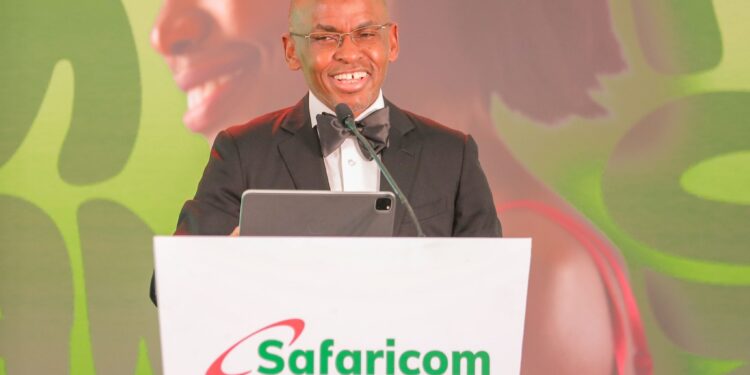Safaricom reaches 50 million customers milestone from a subscriber base of just 17,000 at its inception in 2000. The company has cemented its position as the most dominant telecommunications brand on the continent. Safaricom’s journey mirrors the transformation of Kenya into a digitally connected society. Safaricom’s growth is a compelling story of innovation, resilience, inclusive technology, and deep community integration.
Safaricom CEO Peter Ndegwa says it is the deliberate focus on growing customers that spurred growth
“We are honoured by the trust that over 50 million Kenyans have placed in us. This milestone reflects the deep connection we have built with Kenyans over the past two and a half decades. Our journey has always been about putting customers first, and this achievement is a direct reflection of that dedication. Looking ahead, our next chapter will be about deepening impact, personalising customer experiences, and driving Kenya’s digital transformation agenda,” he said.
This landmark achievement positions Safaricom not just as a mobile service provider but as an institution that has shaped how Kenyans communicate, bank, trade, learn, and live. Its journey, defined by mobile-driven development and digital inclusion, has empowered millions of households and enterprises. As Safaricom celebrates 50 million customers, it offers a moment of reflection on how it got here, and what its journey can teach future business owners.
Safaricom 50 Million Customers Milestone Driven By Innovation
When Safaricom was launched in 2000 as a subsidiary of Telkom Kenya with technical backing from Vodafone, mobile penetration in Kenya was under 1%. Landline services were unreliable and limited, and mobile phones were seen as elitist gadgets. Yet, within its first year, Safaricom laid down a bold strategy focused on accessibility, local content, and affordable mobile services. Within five years, its subscriber base had crossed 5 million, aided by aggressive infrastructure expansion and prepaid airtime services that democratized mobile usage.
By 2010, Safaricom had become synonymous with innovation. The launch of M-PESA in 2007, initially as a simple money transfer tool, would go on to revolutionize financial inclusion globally. Today, M-PESA alone serves over 32 million Kenyans and contributes nearly 40% of Safaricom’s total revenue.
The growth curve has been exponential. In 2015, Safaricom had 25 million customers. That number doubled in just ten years, driven by deliberate investment in 4G coverage (now reaching over 97% of the population), expansion into rural and underserved areas, and bundling mobile services with lifestyle, fintech, and enterprise solutions.
According to Safaricom’s 2024/25 financial report, the company posted KSh 361 billion in revenue, a 12% year-on-year growth. Mobile data accounted for KSh 57.2 billion, M-PESA delivered KSh 130.3 billion, and voice services, despite stagnation industry-wide, still brought in KSh 80.1 billion. Its customer base, now at 50 million, represents over 95% of Kenya’s adult population, with a growing footprint in Ethiopia where it has already signed up 7 million users under the Safaricom Ethiopia banner.
Customer-Centric Approach
Safaricom’s march to 50 million users has not been achieved through infrastructure alone, it has been built on a culture of listening to customers and innovating with empathy. Over the past year, Safaricom has deepened its customer engagement through programs like “Sambaza Furaha” (Share Joy), which turned everyday interactions into community-driven celebrations. By moving into rural markets with roadshows, rewards campaigns, and customer care kiosks, the company met Kenyans where they are, physically and emotionally.
“M-PESA Sokoni” is another game-changer, a digital marketplace embedded into the M-PESA app that connects small businesses with buyers across Kenya. With over 1.3 million small enterprises onboarded by mid-2025, M-PESA Sokoni is not just a platform, it is a vision of Kenya’s digital economy where sellers, service providers, and artisans can thrive without the cost of brick-and-mortar setups.
Moreover, the M-PESA app itself has been redesigned for versatility. It now supports loans, insurance, savings, bill payments, and international remittances. With over 8 million active app users monthly, it serves as Kenya’s most-used fintech application.
How Mpesa Boosted Safaricom Growth
No other product defines Safaricom’s journey more than M-PESA. Introduced in 2007 to simplify mobile money transfers, it now contributes approximately 36% of Safaricom’s total service revenue. As of 2025, M-PESA supports more than 2.3 billion transactions per month, processing over KSh 1.2 trillion monthly.
The growth of M-PESA has been bolstered by its steady evolution into a comprehensive financial ecosystem that caters to a wide range of consumer and business needs. Among its flagship offerings is M-Shwari, a mobile banking service that has disbursed and facilitated savings and loans amounting to over KSh 670 billion.
Fuliza, its innovative overdraft facility, has become a financial lifeline for millions of users, processing an average of 14 million transactions every single day. Additionally, the KCB M-PESA partnership has expanded credit access to customers through tailored mobile loans, further deepening financial inclusion.
M-PESA has also expanded its reach beyond national borders through its international money transfer services, which now connect users across more than 200 global corridors, making cross-border transactions faster and more accessible than ever before.The platform has also become vital for the government and corporate sector. Over 85% of government payments (licensing, NHIF, NSSF, etc.) are now integrated with M-PESA, solidifying its centrality to Kenya’s cashless transition.
- Mobile Data: The New Electricity
Safaricom’s mobile data services, now reaching over 21 million users, contribute nearly 16% of total revenue. The average customer uses 3.9 GB per month, a figure expected to rise with 5G rollouts accelerating in 2025. Safaricom now has over 660 active 5G sites across 35 counties.
The “Lipa Mdogo Mdogo” initiative, which allows Kenyans to buy smartphones on daily installments, has catalyzed smartphone penetration, currently at 73%, up from 52% five years ago. Over 2.5 million smartphones have been distributed through the program.
With 4G coverage nearing saturation, Safaricom’s future data growth will likely come from bundling services like video streaming, health apps, education platforms, and cloud solutions—especially targeting youth and small enterprises.
- Voice and SMS: Still Reliable, Though Declining
While voice and SMS revenues have plateaued due to over-the-top (OTT) apps like WhatsApp, they still contribute a solid KSh 80 billion annually. Safaricom’s success lies in packaging these traditional services with data and device bundles, maintaining relevance across age groups and geographies.
Sustainability and Social Impact
Beyond profits and platforms, Safaricom’s sustainability agenda is one of the most developed in Africa. The company’s approach rests on three pillars: Planet, People, and Purpose.
Green Energy and Environmental Stewardship
Safaricom has pledged to become a net-zero company by 2050. Already, 92% of its network operations are powered by renewable energy, primarily solar. The “Sustainable Business Report 2024” notes that over 2,000 base stations now run on solar power, reducing CO₂ emissions by over 40,000 tonnes annually.
Moreover, its e-waste management program has safely recycled over 2,000 tonnes of electronic waste since 2012, in partnership with Waste Electrical and Electronic Equipment Centre (WEEE Centre).
Inclusive Employment and Local Empowerment
Safaricom employs over 6,500 people directly and supports an estimated 200,000 indirectly across its dealer and agent networks. It has won repeated global recognition for gender equity, women represent over 35% of senior leadership.
Youth empowerment remains a key focus. The Safaricom Digital Talent Programme has trained over 10,000 young developers and data scientists. The recent “Safaricom Youth Fund”, launched in 2024 with KSh 500 million in seed capital, offers grants and incubation support for digital startups.
Education, Health and Disaster Relief Driving Safaricom In The Community
Through the Safaricom Foundation, over KSh 5 billion has been invested in community health, education, and emergency response programs. During the COVID-19 pandemic, Safaricom donated over KSh 1.5 billion in resources and infrastructure, including ventilators, PPEs, and free data for medical staff.
Education-focused programs like “Maji na Uhai” (Water and Health) and “Ndoto Zetu” have directly impacted over 1.2 million Kenyans. The Foundation also supports over 300 primary and secondary schools annually with digitized learning resources and internet access.
Regional Expansion As A Growth Driver
Safaricom’s pan-African aspirations have begun to crystallize. Its operations in Ethiopia, launched in 2022, are now a cornerstone of its long-term strategy. With over 7 million customers already and a rapidly expanding network in Addis Ababa and Oromia, Safaricom Ethiopia is projected to contribute 15–20% of group revenues by 2030.
In the meantime, Safaricom is doubling down on home internet services, IoT (Internet of Things), and cloud computing. With Kenya’s digital economy poised to contribute 10% to GDP by 2030, Safaricom sees itself as the backbone of this transformation, connecting people, businesses, governments, and ideas.
What Happens Next After Safaricom Reaches 50 Million Customers Milestone?
Safaricom’s journey to 50 million customers is not just a corporate success story; it is a lens into Kenya’s digital awakening. In just 25 years, the company has grown from a small mobile operator into a critical force in fintech, social impact, digital infrastructure, and national resilience.
Its growth has been powered by understanding the pulse of the nation, whether through affordable services, customer-centric design, or visionary leadership. Safaricom has built not just a network, but a digital lifeline for millions. And as it prepares for the next frontier, cross-border expansion, AI-driven services, and a green digital future, its impact is bound to reverberate far beyond Kenya’s borders.
In hitting the 50 million mark, Safaricom has not just celebrated a number. It has underlined its place in the heart of every Kenyan household and secured its legacy as one of Africa’s most transformative companies.
ALSO READ: Safaricom Unveils Ziidi Money Market Fund












